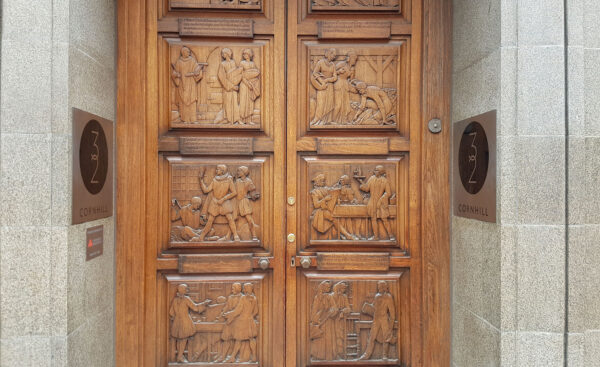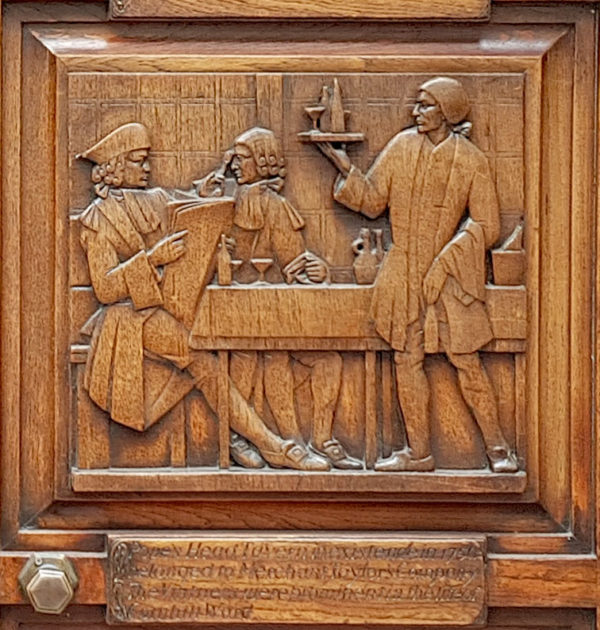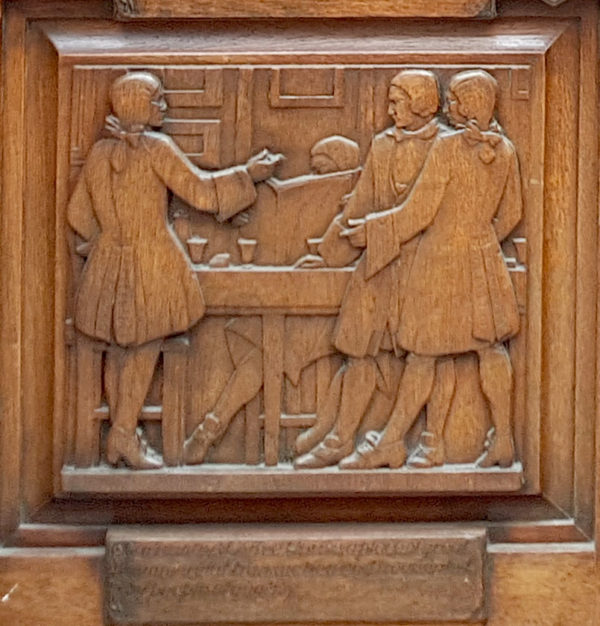There is a wooden door near Bank tube station that’s worth paying a visit to at weekends, for only then can it be truly admired. That’s because at weekends the doors are closed, and easy to admire, and during the week, somewhat less easy as they’re folded open and people use the doorway for doorway purposes.
The doors, and indeed the whole building was constructed for Cornhill Insurance, as their head office in the 1930s. Cornhill Insurance was founded in 1905 by the directors of Willis Faber initially as a fire insurance company. Although its corporate head office was based on Cornhill, its main office was set up in 1953 in Guildford.
The company was bought by Thomas Tilling — which used to be a major bus company — in stages between 1943 and 1973, and later sold to the German insurer Allianz in 1986, who dropped the Cornhill name in 2007.
While the building is fairly decently conventional for the time, it was the Arts and Crafts sculptor, Walter Gilbert who got the job of decorating the doors. He was already fairly famous for doing up doors, having won the commission for the massive bronze doors inside Freemason’s Hall, and the ornate gates at Buckingham Palace.
Then he won this modest commission, to carve a design by the Birmingham artist, Bernard Philip Arnold, and what a marvellous job he did – eight deeply engraved panels showing key events in the area’s history.
St Peter’s Cornhill founded by King Lucius 179 A. D. to be an Archbishop’s see and chief church of his kingdom and so it endured the space of 400 years until the coming of Augustine the monk of Canterbury
Lucius of Britain was a legendary 2nd-century King of the Britons and Saint who is traditionally credited with introducing Christianity into Britain. There’s no evidence that he actually existed, although his name is carved in a much later stone at the nearby St Peter upon Cornhill church, which he here being shown approving.
Eleanor, Duchess of Gloucester, did penance walking barefoot to St Michael’s Church from Queen Hithe, 1441
What you might say was the original “shame bell” moment, as the Duchess, found guilty of “treasonable necromancy” after seeking a horoscope on the then King, and was forced to walk barefoot to seek penance, while holding a lit taper. She was then sentenced to life imprisonment in a number of castles.
Cornhill was anciently a soke of the Bishop of London who had the Seigneurial oven in which all tenants were obliged to bake their bread and pay furnage or baking dues
At a time when few people had kitchens, the Bishop of London owned the communal oven for the area and charged a hefty fee to use it — and in this situation as it was a Seigneural Oven — it was, in fact, illegal to own a private oven.
The ladies in the carving don’t look too happy, which is understandable.
Cornhill is the only market allowed to be held after noon in the 14th century
Unsure if true, but the market was important and was recorded by John Stow as selling food and clothing.
Birchin Lane, Cornhill, place of considerable trade for men’s apparel, 1604
Tailors work on the nobleman who is admiring his appearance, if not the clothing in the mirror. Birchin Lane was originally known as Bercheneres Lane, and the quote above comes from John Strype’s Survey of London.
Pope’s Head Tavern in existence in 1750 belonged to Merchant Taylor’s Company. The Vintners were prominent in the life of Cornhill Ward.
A once-famous pub, with an alley named after it. In a Masque about Christmas, written by Ben Johnson and performed for King James I, there is a character who says “I am Gregory Christmas, and although I come out of Pope’s Head Alley, I am as good a Protestant as any in my Parish,”
This was notable as at the time, the Puritans were starting their long campaign against Christmas as being overly Catholic, so having a line about Christmas coming from Pope’s Head, but still being Protestant was a less than subtle dig at the puritans.
Garraway’s Coffee House, a place of great commercial transaction and frequented by people of quality
A famous coffee house set up by Thomas Garraway in Change Alley and was one of the largest in London, being built after the Great Fire of London. It closed down in 1866.
The remark about the people of quality comes from John Macky’s A Journey through England, where he mentions Garraway’s as one of three celebrated coffee houses in Exchange Alley where “People of Quality who have Business in the City, and the most considerable and wealthy Citizens frequent”.
Thackeray and the Brontes at the publishing house of Smith Elder & Co. Cowper, the poet, Gray the poet, Guy, the bookseller and founder of Guy’s Hospital, lived in Cornhill.
The panel depicts Charlotte and Anne Bronte meeting with the satirist, William Makepeace Thackeray at the premises of Smith Elder, who for a while also published Cornhill Magazine.
The address, 32 Cornhill also has had an illustrious history, and was once occupied by James Asperne (1757-1820), bookseller, freemason, and publisher of the The European Magazine. In 1803, he became successor to John Sewell at the Bible, Crown and Constitution, No. 32 Cornhill.
















